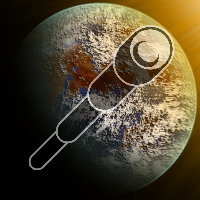Torch Drive
A spacecraft engine capable of providing both high acceleration and efficient fuel consumption.
To support the drive's operation large tanks of fuel and reaction mass are required, usually located between it and the crew cabin to provide additional shielding. Fuel refers to fusion fuel, while reaction mass can be injected into the engine to provide additional acceleration. Most torch drives run on deuterium-tritium, deuterium-helium 3, or proton-boron fusion reactions. Deuterium-deuterium is possible but rarely used since it produces neutron radiation. A set of high-temperature radiators are also required to shed waste heat from the torch.
History
Early space propulsion systems fell into one of two categories: powerful but inefficient engines for lifting ships into orbit against a strong gravity well such as Terra's, or deep-space drives which were very efficient but only produced meager acceleration and thus slow travel times. A torch drive combines the advantages of both to enable fast and efficient spaceflight across interplanetary distances. How the term "torch drive" became attached to this concept is unknown, most historians believe it comes from ancient science fiction literature.Details
A modern fusion torch consists of a flat or conical heat shield ringed by a driver coil creating a magnetic field with a pinch point below the ship. Fuel pellets are shot out into the field where they are compressed and ignited with lasers, detonating and transferring momentum to the ship as the field directs the plasma into a concentrated jet. By standing the fusion reaction off below the ship, only a tiny percentage of its waste heat is intercepted by the shield at the bottom. Even so, torch power outputs are so colossal that the heat shield and its radiators will glow orange-hot.To support the drive's operation large tanks of fuel and reaction mass are required, usually located between it and the crew cabin to provide additional shielding. Fuel refers to fusion fuel, while reaction mass can be injected into the engine to provide additional acceleration. Most torch drives run on deuterium-tritium, deuterium-helium 3, or proton-boron fusion reactions. Deuterium-deuterium is possible but rarely used since it produces neutron radiation. A set of high-temperature radiators are also required to shed waste heat from the torch.


It's always nice to see content like this (at least for myself) i'm almost reminded of Project Daedalus. By the way, I don't suppose you have visited Winchell Chung's website atomic rockets have you? There's tons of details on many different drives on there.
Yep, Atomic Rockets is one of my major sources for space travel science!
Ah, glad to see another user of that website.